Openwork knitting products never go out of fashion. Knitting openwork patterns with knitting needles will not be difficult even for beginners if you use patterns with descriptions. Following the instructions for action, create practical and beautiful knitted products.
Preparing for work and choosing a knitting pattern
To create a knitted product, special attention is paid to the yarn and the size of the knitting needles or hook. The density of the knitting depends on this.
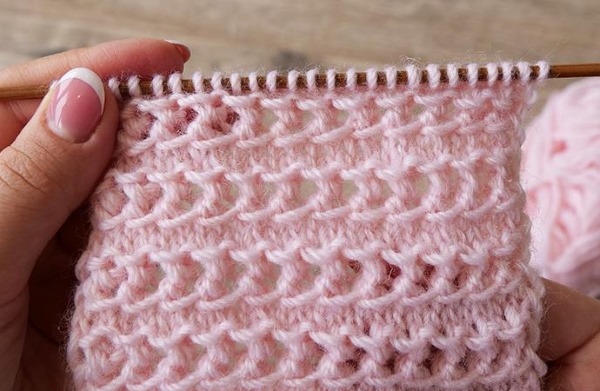
The choice of pattern determines how the product will look. 2 identical items knitted in different ways will differ greatly. When choosing a pattern, focus primarily on the ease of execution of knitting. Beginner knitters are advised to try their hand at simple knitting patterns. As you gain skill, you can move on to more intricate designs.
The appearance of a product is influenced not only by the pattern, but also by the yarn used. The composition of the yarn affects how the product sits on the figure, how warm, thin or voluminous it will be.
Tips for choosing and preparing material
| Stage | Action |
| Selection of material |
|
| Amount of yarn |
|
| Preparation of material |
|
Knitting patterns for openwork patterns for beginners
Knitting with knitting needles (openwork patterns, diagrams with descriptions are presented below) using simple examples is not difficult for beginner knitters.
Examples of simple patterns, where ЛЦ (front), ИЗ (purl), НК (yarn over):
- The pattern is repeated every 8 loops and 12 rows in height. Purl rows are knitted - PU.
1 row: taking into account the set of 24 loops - 3 LC, *1NK, 2 together to the left, 6 LC*, *repeat, 1NK, 2 together to the left, 3 LC
3, 5 rows: all LC.
Row 7: 7LC, *1NK, 2 together left*, 6LC, *repeat, 7LC.
Rows 9,11: all LC.
- Cast on 16 stitches for the pattern and 2 side stitches. If necessary, add 8 stitches. Repeat the pattern every 12 rows.
Rows 1,5,7,11: all LC.
Rows 4, 6, 10, 12: all IZ.
2nd row: 8 IZ, 1H, 2 together to the left, 4 IZ, 2 together to the right, 1NK.
Row 3: 8LC, 1NK, 3 slip on a pin, 3LC, return the slipped stitches and knit LC, 1NK.
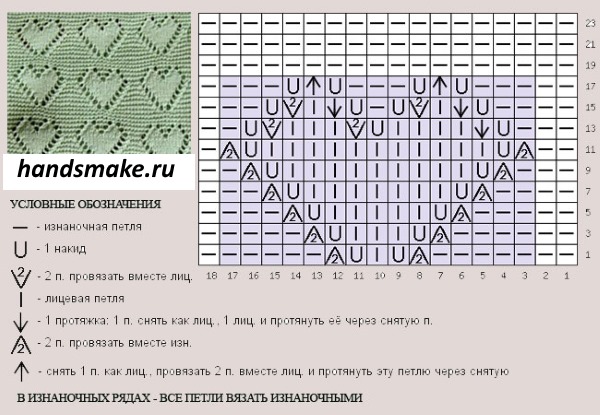
Row 8: 1NK, 2 together to the left, 4IZ, 2 together to the right, 1NK, 8IZ.
Row 9: 3 loops are removed onto a pin, 3 LC, 3 removed loops are returned and LC is knitted, 1 NC, 8 LC.
Openwork elastic band
Knitting with needles (openwork patterns, diagrams with descriptions allow you to make stylish things) is most often practiced using the elastic method. To make the product more elegant, combine the openwork pattern with the elastic.
This combination makes the product durable, elastic and original. A similar pattern can be made with knitting needles and a crochet hook, but knitters prefer knitting needles, since the product is more durable.
Openwork elastic bands are divided into subtypes according to the type of pattern: rings, lace, ribbing and others. Each of the types of knitting these patterns can differ greatly from each other, so needlewomen give preference to one of the methods.
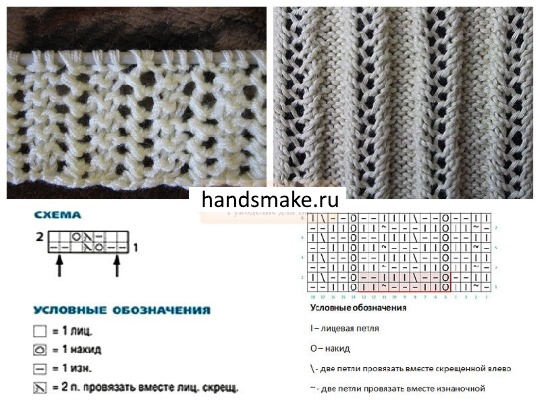
Classic execution of elastic band from high-quality yarn makes the product durable and long-lasting. Knitting with a uniform pattern looks laconic. If desired, simple elastic knitting is complemented with openwork inserts.
Cast on stitches (quantity is a multiple of 4 +1):
- 1st, 3rd rows of the front: 1LC, 3 IZ*, 1LC, *repeat algorithm.
- Rows 2, 4, 6: 1 IZ, 3 LC*, 1IZ, *repeat algorithm.
- Row 5: 1LC, 2 IZ together*, 1NK, 1IZ, 1LC, *repeat algorithm.
- The pattern is repeated every 6 rows.
Openwork socks with knitting needles
Before you start knitting, take measurements for the future product: calf circumference (A), instep height (B) and heel (C), foot length (D).
Make a sample from the material chosen for knitting in a 10 cm square. Calculate how many loops and rows there are, and divide each figure by 10. Get the number of loops (E) and the number of rows (F) on a scale of 1 cm. Multiply these values by the measurements and start knitting.
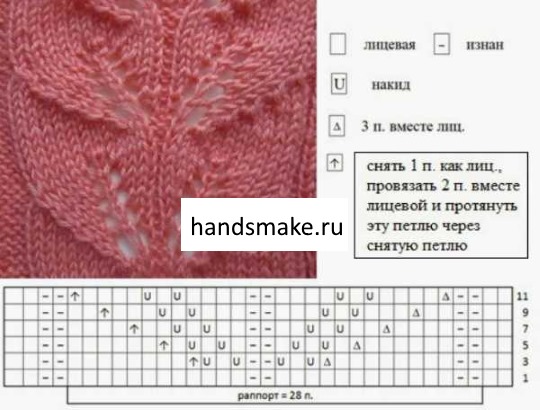
Sequence of actions:
- Cast on the required number of loops (E*A).
- Distribute the loops onto 4 knitting needles and prepare the 5th knitting needle for throwing the loops over.
- Knit the desired height clockwise.
- When the height is gained, start knitting the heel. Count the loops, divide their number in half. One part is lengthened: grab 1 loop from the second part in each new row. Knit like this until the 2 parts are connected again.
- Knit a certain length clockwise. The required number of rows is calculated using the formula F*C.
- Continue knitting until there are 5 rows left to the end of the length.
- From the current number of loops -6 and divide this number by 5. The resulting number is the number of loops. They are connected until 6 remain.
- The thread is cut, passed through the remaining loops and tightened.
The openwork pattern starts from the tips of the toes and goes up the front side of the socks. The pattern is divided into 12 loops and 5 rows. The loops are cast on, to the circumference of the shin and distributed over 4 knitting needles. Knit 3 rows of IZ and start the openwork. In the pattern, all even rows are done IZ. In the diagram below, repetition of elements is marked with the * sign.
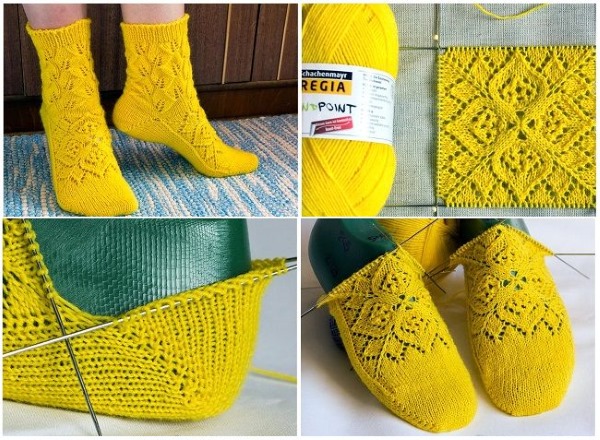
Knitting pattern:
- 1st row: 4 IZ, 2 together, 2 together, *1NK, 1LC*, 3 times*, 1NK, 2 together, 2 together, 4 IZ.
- Row 3: 3 OUT, 2 together*, *repeat, then OUT.
- Row 5: 2 OUT, 2 together, 2 together, 1 NK, 1LC, 1 NK*, 5LC, 1 time*, 2 together, 2 together, 2 OUT.
Another example of a simple pattern for socks in the form of hearts. The pattern takes 13 loops and 16 rows. It is distributed across the entire width of the socks or only on the front side. All even rows are made IZ. Periodically in the pattern, a draw through (P) is performed: one loop is removed as a front one, the next one is made LC and drawn through the previous one.
Knitting pattern for openwork socks with a heart pattern:
- 1st row: 6 LC, 1NK, 1P, 5LC.
- 3rd row: 4 LC, 2 together, 1 NK, 1 LC, 1 NK, 1P, 4 LC.
- Row 5: 3 L, 2 together, 1NK, 3 LC, 1NK, 1P, 3 LC.
- Row 7: 2 LC, 2 together, 1 NK, 5LC, 1 NK, 1P, 2LC.
- Row 9: 1 LC, 2 together, 1 NK, 7LC, 1 NK, 1P, 1LC.
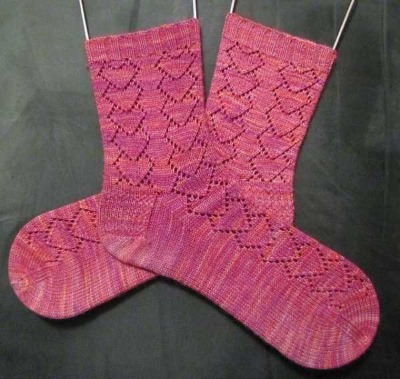
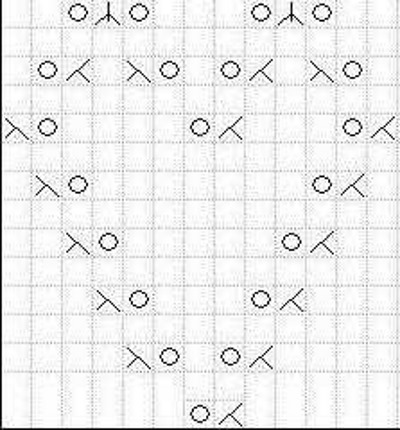
- Row 11: 2 together, 1 NK, 4LC, 1NK, 1P, 3LC, 1NK, 1P.
- Row 13: 1 LC, 1NK, 1P, 1LC, 2 together, 1NK, 1LC, 1NK, 1P, 1LC, 2 together, 1NK, 1LC.
- Row 15: 2 LC, 1NK, remove 1, 1NK, 3 LC, 1NK, remove 1, 1NK, 2 LC.
Openwork women's circular scarf-snood
Knitting a snood scarf with knitting needles (openwork patterns, diagrams with descriptions help to obtain sophisticated works) takes a little time. Adding openwork elements can complicate the task for the knitter.
Openwork snood "Herringbone"
To create a scarf you will need: knitting needles No. 5, 200 g of yarn (65: wool, 35: alpaca). Cast on the required number of loops (multiple of 13 + 2). Knitting increases in width, where the first and last loops close, forming a ring. The length of the snood depends on the number of loops. For medium length, 210 loops are enough.

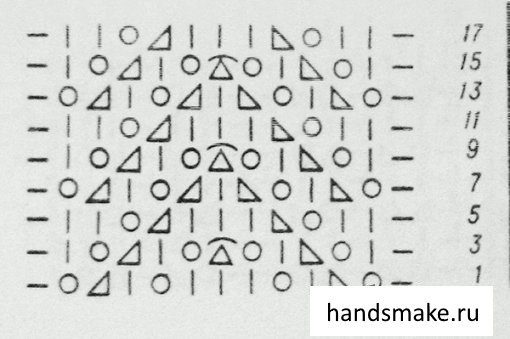
Knit rows of LC until the scarf edging is formed. Start with the openwork: 1 slip as LC, 2 together, NK of the slipped loop onto the knitted one. Continue in the same way.
Openwork
According to another scheme, the pattern is designed for 21 loops and 11 rows. Cast on 233 loops, start knitting, forming a pattern horizontally. To do this, knit 3 rows of garter stitch and start the openwork.
Rows 1, 3, 5: 1LC, 1NK, 2 together to the right. The algorithm is performed throughout the row.
Rows 7, 9, 11: 1LC, 2 together left, 1H. Algorithm for the entire row.
Next follow 5 rows of garter stitch and continue to form an openwork pattern.
1, even with 2 - 22 and 23 rows - LC.
Rows 3, 7, 11, 15, 19: 1L, 2 together to the right, 1NK, 1LC, 1NK, 2 together to the left, 1LC – algorithm for the entire row.
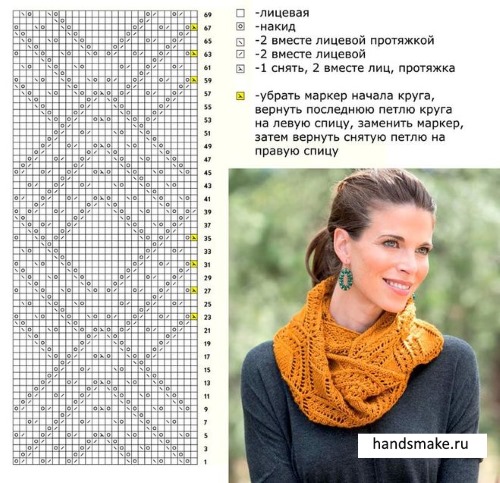
Rows 5, 9, 13, 17, 21: 2 together to the right, 1 NK, 3 LC, 1 NK, 2 together to the left – algorithm for the entire row.
Every odd number is LC. Then the pattern is done in reverse order: 5 rows of garter stitch, 11 rows of pattern.
Children's scarf
Knitted openwork children's scarves with different patterns (according to the scheme with description) are in demand among many knitting mothers. The unusual design of familiar wardrobe items emphasizes the style of young fashionistas. To make an openwork scarf, beginning needlewomen use simple schemes.
Elastic band with dropped loops
For such a scarf you will need knitting needles No. 2, Australian merino yarn 200 g (800 m). Cast on stitches (multiples of 11 + 7). Repeat the pattern - 4 rows.
1 front row: 3 WS, 1 WS, 3 WS, 1 slip, 1 WS, 3 WS, 1LC*, 1 WS, 2LC together, 1LC, 3 WS, 3 WS, 1 slip, 1 WS, 3 WS, *repeat.
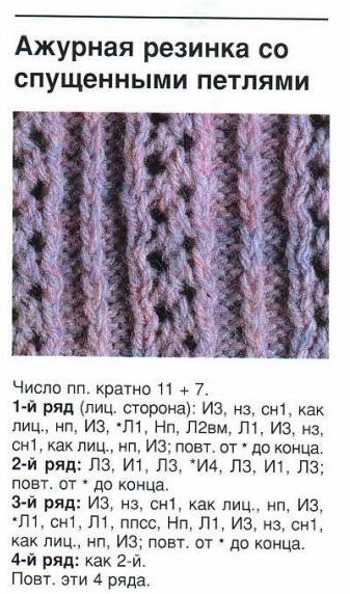
2nd row: 3 LC, 1 IZ, 3 LC, 4 IZ*, 3 LC, 1 IZ, 3 LC, *repeat.
3rd row: 3 WS, 3 WS, 1 slip, 1 WS, 3 WS, 1 LC*, 1 slip, 1 LC, 1 slip, 1 WS, 1 LC, 3 WS, 3 WS, 1 slip, 1 WS, 3 WS, *repeat.
4th row, like the second and further, repeat every 4 rows.
Rings
The pattern consists of 7 rows, where each 5th is repeated. Section * is repeated the required number of times.
1st row: 2 IZ*, 2 LC, 2 IZ*.
Row 2 and all other even rows are knitted as the loops lie.
3rd row: 2 IZ*, 2 LC, 1 NK, 1 LC*, 2 IZ.
Row 4: according to the pattern, all NK from the previous row – IZ.
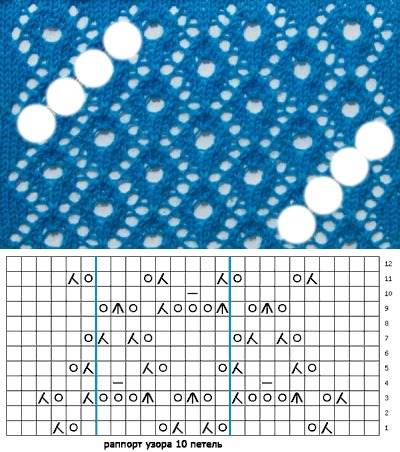
Row 5: 2 IZ*, 3 LC, with the left knitting needle grab the far right loop and tighten into 2 loops on the left*, 2 IZ.
Row 7: algorithm for row 3.
Stole
Volumetric scarves with an openwork pattern are a beautiful and practical detail in the winter wardrobe. Shawls and stoles made of wool yarn retain warmth and complement a woman's image. Below are diagrams for creating original scarves.
Method 1
Using 3 skeins of yarn of 100 g (150 m) according to this pattern, you get a stole measuring 30 * 160 cm. The pattern takes up 13 loops and 16 rows. To create the stole, use 8 mm knitting needles. Cast on 71 loops and knit 14 rows in garter stitch.
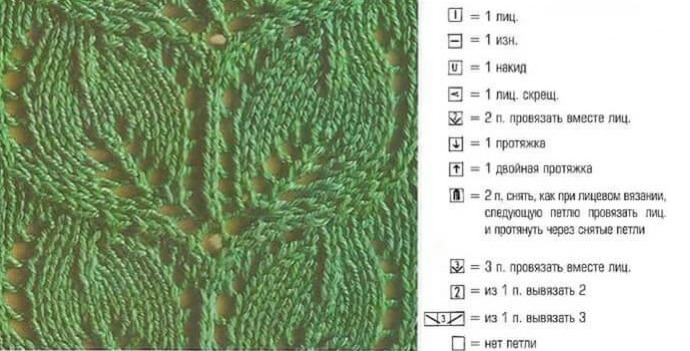
1st row: 4 LC, 4 LC*, 1 NK, 2 LC together, slip 1, pull 2 LC over the slipped one, 1 NK, 2 LC to the left, 1 NK, 5 LC, repeat with * to 3 side LCs.
2nd row: 3 LC, all IZ, 3 LC - side.
Next is the pattern diagram, which is repeated from rows 1-36 6 times, then repeat rows 1-25, after 14 rows of garter stitch and closing. The pattern is 15 loops (from 5-20), it is repeated the required number of times.
| Reduction | Transcript |
| LC | Facial |
| FROM | Purl |
| NK | Yarn over |
| LV | 2 face stitches are connected |
| LVV | 2 front loops are knitted with a left tilt |
| P1 | the loop is removed as a front loop, 2 front loops are pulled through the removed loop |
| P2 from behind | remove 2 loops on a pin behind knitting, 2LC, 2 removed loops are knitted LC |
| P2 front | remove 2 loops on a pin before knitting, 2LC, 2 removed loops are knitted LC |
All even rows – IZ, 3 side rows on both sides – LC:
- 1st row: 6 LC, LV, NK*, *repeat, 3 LC, NK, LVV, NK, LVV, 3 LC.
- 3rd row: 5 LC, LV, NK*, *repeat, 5 LC, NK, LVV, NK, LVV, 2 LC.
- 5th row: 4 LC, LV, NK*, *repeat, 7 LC, NK, LVV, NK, LVV, 1 LC.
- 7th row: 7 LC, LV, NK*, *repeat, 8 CL, NK, LVV, NK, LVV, P1.
- Rows 9, 13, 17: 3 LC, LVV, NK*, *repeat, P2 in front, 1 LC, P2 in back, NK, LV, P1.
- Rows 11, 15: 3 LC, LVV, NK*, *repeat, 8 LC, NK, LV, NK, P1.
- Row 19: 5 LC, NK, LVV*, *repeat, 5 LC, LV, NK, LV, NK, 2 LC.
- 21 row: 6 LC, NK, LVV*, *repeat, 3 LC, LV, NK, LV, NK, 3 LC.
- 23rd row: 7 LC, NK, LVV*, *1 repeat, LC, LV, NK, LV, NK, 4 LC.
- 25 row: 8 LC, NK, LVV*, *repeat, P1, LV, NK, LV, NK, 5 LC.
- 27, 31, 35 rows: 4 LC, P2 in back, NK, LV, NK, P1, LVV, NK, P2 in front, LC.
- 29, 33 rows: 8 LC, NK, LV, NK, P1, NK, LVV, NK, 5 LC.
Method 2
Another method of creation requires 4 mm knitting needles, 100 g (360 m) wool yarn is used as material. With this amount of material, a stole measuring 70*1700 cm is obtained.

Cast on 44 loops, including side loops. The pattern is repeated from 4-26 loops horizontally and in 16 rows upwards. From 10-16 rows, the previous ones are repeated in mirror image.
The stole begins and ends with 3 rows of garter stitch:
- 1st, 9th rows: 2 LC, IZ, 12 LC*, * repeat twice, IZ, 2 LC.
- Rows 2, 8: 3 LC, 12 IZ, LC*, *repeat, 12 IZ, 3 LC.
- 3rd row: 2 LC, *IZ, NK, 4 LC, LVV, LV, 4 LC, NK, IZ*, P2 back, 2 LC, P2 front, *repeat, 2 LC.
- 4th row: 3 LC, *IZ, NK, 3 IZ, LVV, LV, 3 IZ, NK, IZ*, LC, 12 IZ, LC, *repeat, 3 LC.
- 5 row: 2 LC, IZ, *2 LC, NK, 2 LC*, LVV, LV, *repeat, IZ, 3 LC, P2 back, 3 LC, IZ, *repeat, LVV, LV, *repeat, IZ, 2 LC.
- 6th row: 3 LC, 3 FROM, NK, FROM, LVV, LV, FROM, NK, 3 FROM, LC, 12 FROM, LC, 3 FROM, NK, FROM, LVV, LV, FROM, NK, 3 FROM, 3 LC.
- Row 7: 2 LC, *IZ, 4 LC, NK, LVV, LV, NK, 4 LC, IZ*, P2 back, 2 LC, P2 front, *repeat, 2 LC.
Openwork sweaters
Inserts of openwork patterns add a more festive or romantic look to sweaters. The insert is made on the sleeves, neck, front parts or only the back. The choice depends on the knitter's wishes.
Blouse with wide sleeves
You will need: knitting needles No. 4, yarn 45% cotton, acrylic and 10% polyamide (100 g - 200 m). Total consumption - 500 g. Perform the "knot edge" knitting: each time remove the first loop as a front one, knit the last one as a front one - the whole product. Knitting of such a model occurs from the left sleeve to the other.
Cast on 20 stitches and knit the dropped stitches. Add stitches on both sides: starting from the 3rd row, add 1 stitch on the left every 2 rows. Do this 19 times, then add 2 stitches 3 times, 3 stitches 2 times, 5 stitches 1 time.
At the same time, the sleeve bevel is formed on the right side: in the fifth row, 1 loop is added on the right, then in the 4th, in the 6th, 1 loop is added (repeat the algorithm three times).
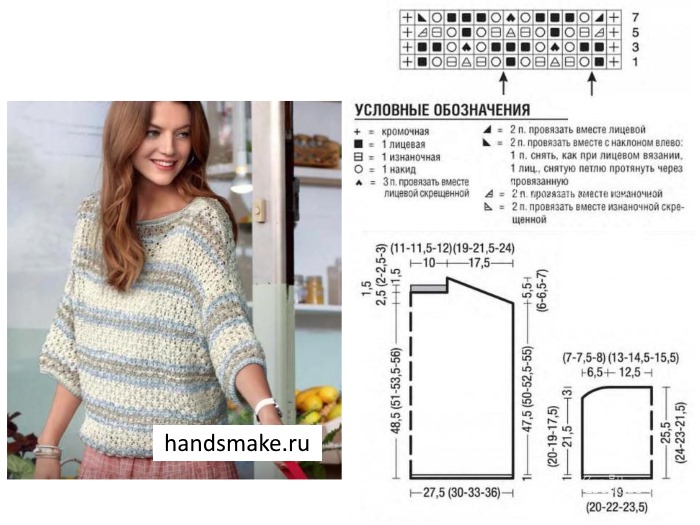
On row 58, cast on 16 loops from the left and continue knitting another 54 rows (half of the back). Finish knitting the product in reverse order. The front part is knitted in the same way as the part from the back, but all actions are mirrored. The product is sewn with side seams and at the shoulders.
Summer sweater with a "cone" pattern
For the product you will need: knitting needles No. 6, yarn with 75% cotton (100 g per 200 m), total material consumption – 500 g.
The pattern uses 2 elements:
- Patent. In the front rows, the outer 4 loops are knitted with the LC. In the back rows, they are removed, holding the thread in front of the loops, tightening them.
- "Cone". The diagram below is a 10*10 square with 14 rows of 15 stitches. Based on this calculation, the required pattern is formed.
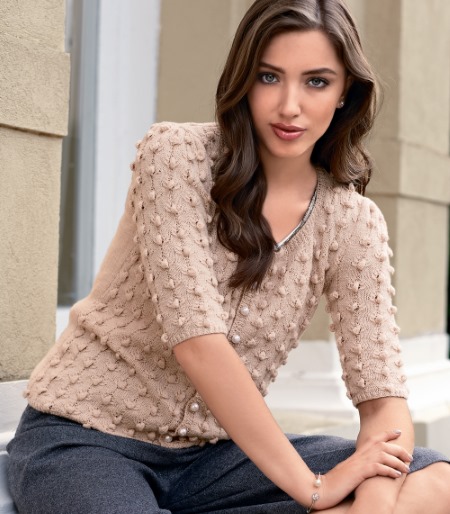
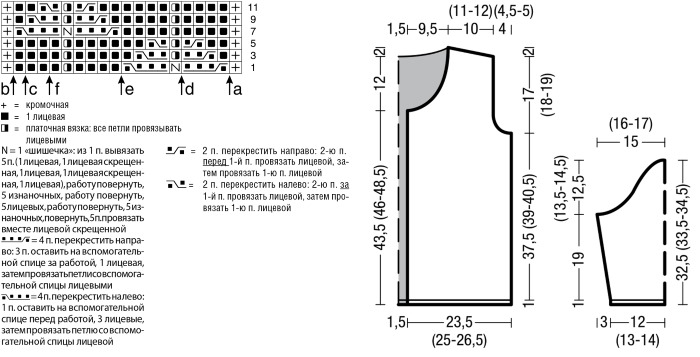
Knitting pattern:
- 1st row: side, 2 LC, *make 5 from 1 (alternating LC and crossed), NK, 3 together IZ, NK*, *repeat twice, side.
- 2nd row: side, *NK, 3 together LC, NK, 5 together IZ*, *repeat twice, side.
- 3rd row: side, 2 together with a draw through (1 is removed as a front one, 1 LC and pulled through the removed one), *НК, from 1 make 5*, 3 together ИЗ, *repeat, side.
- 4th row: side, *IZ, 5 together IZ, NK*, 3 together LC, NK, *repeat, 2 together IZ, side.
Cast on 70 stitches and knit with purl knitting, then knit 60 rows with the "Bump" pattern. From the 61st row, add 19 stitches on both edges. Knit 26 rows this way, but make a patent on the edges. Close the 27th row. The front part of the sweater is knitted similarly. The product is sewn on the sides and at the shoulders.
Women's cardigan
Knitting with knitting needles (openwork patterns, diagrams with descriptions of models are presented below) for beginners is possible in the form of cardigans. Light pattern and woolen material make the knitted product warm and weightless at the same time.
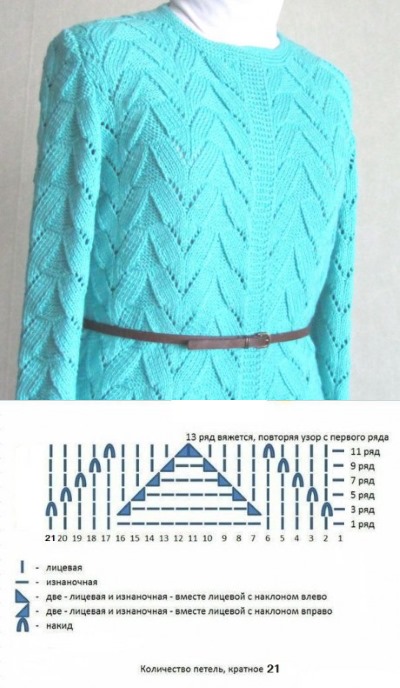
If you don't want to make the cardigan completely openwork, make inserts: only the back, sleeves, front lines. You will need: yarn 86% mohair 50 g per 200 m (total 250 g), knitting needles No. 4.5.
Back
Cast on 68 stitches and make 100 rows of LC. Then knit 12 rows of classic elastic and another 2 rows of LC. Then start forming the pattern by knitting the openwork element of the pattern for 20 rows.
To make openings for the sleeves, count the 135th row and close 4 side loops on both edges. After a row, close 2 and 1 loop until there are 54 loops left on the needles. The back is closed on the 173rd row.
Openwork pattern diagram:
- 1st, 7th rows: IZ, *4 LC, 2 together LC, NK, LC, NK, 2 together crossed*, *repeat, 4 LC, IZ.
- 3rd, 9th rows: IZ, 3 LC, *2 together LC, NK, 3 LC, NK, 2 together crossed*, 2LC, *repeat, 3 LC, IZ.
- Rows 5, 11: IZ, 2 LC, *2 together LC, NK, 5 LC, NK, 2 together crossed*, *repeat, 2 LC, IZ.

All even rows are IZ.
Half and sleeve
To form the right half:
- Cast on 35 stitches and knit 100 rows of LC, 12 rows of ribbing, 2 rows of LC.
- Next, use the openwork pattern indicated above, 20 rows.
- Starting from row 115, close 1 side loop on the left, then in every 4th row 9 times 1 loop, in every 2nd row – 4 times 1 loop.
- The opening is formed from the 135th row: close 4 side loops on the right, then every other row 2 and 1 loop.
- There are 14 loops left and in row 173 the knitting is closed.
- The left half is formed in a mirror image.
For the right sleeve:
- Cast on 70 loops and knit 2 rows of LC, making an openwork pattern over 30 rows.
- In the 33rd row, close 35 loops so that there are 35 loops left on the needles.
- Next rows: 1 purl, 4 elastic, 2 front surface, 36 openwork pattern.
- The expansion of the sleeve begins from the 39th row: add 1 loop on each side.
- Next, in every 6th row, add 1 loop 5 times so that there are 47 loops on the needles.
- The sleeve ends on row 105.
- The left sleeve is knitted using the same principle.
- Sew the back, sides and sleeves together.
Various methods of knitting openwork patterns (using diagrams with descriptions) allow you to create unique wardrobe items. Openwork patterns can be combined with elastic for elasticity of the product, but the durability is also affected by the composition of the yarn.
Article formatting:Natalie Podolskaya
Video about knitting openwork patterns
Knitting - openwork patterns (diagrams with descriptions):
